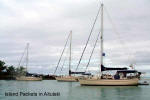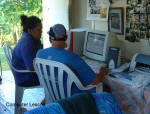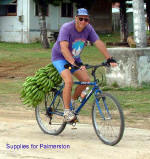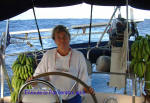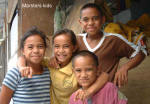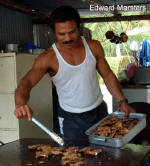American Samoa and Samoa
Cook Islands Fiji
Marquesas Moorea
New Caledonia
Pacific Crossing
Pacific Log Pacific Route
Society Islands
Tahiti Tonga
Tuamotus Vanuatu

June 2003
Aitutaki
We had spent a lot of time watching the weather for this next passage as in 2002 and again in 2003 many boats had encountered difficult conditions in this area. In 2003 it seemed there was a constant convergence zone and cold front moving back and forth North to South over the Cook Islands. After 2 weeks of waiting we picked what we thought would be a good weather window and departed from Mopelia.
For 2 days we motored with no wind but large swells rolling the boat side to side. The swells were left over from a storm 1,500 miles south of us. On the last day of our trip the wind filled in. That is it went from 8 knots to 30 knots in about 20 minutes and began a 10 hour long driving rainstorm. The rain was so dense we could not see 100 yards in front of the boat so for the first time in 25,000 miles of passagemaking we simply gave up watchkeeping and went below. In only a short while the wind opposing the swells built very steep seas that constantly broke against the hull and cabin top of Ventana. Each breaking wave would jolt the boat and shove her sideways in the water several feet. The noise was horrendous. We both wore ear plugs and in order to sleep the off watch person also donned a pair of heavy duty ear protectors like you see jet airplane mechanics wear. At this point we were down to double reefed main and small staysail and we kept Ventana moving slowly ahead.
We were later to find out that most of the other boats in the same waters were hove to and drifting with the storm. Fortunately Ventana is much stronger than we are and she brought us through the difficult conditions in good shape. Nevertheless we were very glad to sight Aitutaki at dawn the next morning and by 10 am we had navigated the shallow, curving entrance channel and were safely anchored in the lagoon.
The Cook Islanders are certainly the friendliest people on earth and everywhere we were made welcome. After we got our land legs back we pulled out our folding mountain bikes and explored nearly every road on the island. Each afternoon we would take off in a new direction and it was a normal occurrence for people we passed to drop whatever they were doing to wave to us and yell hello. A familiar site along the roads was the family plot in each front yard with the graves well tended and full of fresh flowers.
We became friendly with one couple who later explained that they had a computer and internet connection but that neither the mouse, printer nor internet connection were working. Rob returned to their home each day for the next week, fixed everything and gave daily computer lessons. In return we pedaled home each afternoon with loads of bananas, papayas, limes and more.
Aitutaki has a small but growing tourist industry and we took advantage of this to go on a guided lagoon exploration. Normally we would do this in our own dinghy and find what we could but here we decided to play tourist and let the guided trip guarantee us of seeing the high points. The trip was fairly expensive but well worth it for the exploring, fantastic lunch and the excellent snorkeling we would not have found on our own. Nevertheless I could not help reflect that only a week before on virtually uninhabited Mopelia we had met a Tahitian named Vetea on the beach and he had given us the same type of guided tours of his atoll day after day. With Vetea no money changed hands- just a sincere exchange of friendship and a desire to share our lives with each other. Such is the price of progress.
The anchorage at Aitutaki is very small and at most can handle 8-9 boats. Most times it has only 1 or 2, so it was astonishing that a few days later there were only 3 boats in the harbor and all were Island Packets the same as Ventana. We had not discussed it or planned it but 3 of the 4 Island Packets in this part of the Pacific had all ended up in the same anchorage at the same time.
Palmerston Island
Our next stop was to be Palmerston Island one of the most unique places in the world. To understand Palmerston you must first understand a bit about the Cooks. The Cook Islands comprise about 20 islands with a total land area of 93 sq. miles spread over three quarters of a million sq. miles of ocean.
Palmerston is 8/10 of a sq. mile in surface area and the nearest inhabited island is over 200 miles away. This however is not what makes it unique. In 1863 a Scotsman named William Marsters moved to Palmerston with his 3 Polynesian wives. He had 21 children and today all 53 inhabitants are his descendents and all share the last name Marsters. At one time there were over 150 inhabitants - all Marsters- but now some have moved off elsewhere in the Cooks and on to New Zealand.
Palmerston only gets a supply boat 2-3 times per year so our visit would be part of their thin lifeline to civilization. In 2001 the island finally got one telephone so we were able to call ahead and ask what supplies they might need. We loaded Ventana down with sacks of flour, sugar, rice, canned goods, and as much fresh produce as we could carry. The couple whose computer we had repaired in Aitutaki pitched in and donated bananas and melons from their small plantation.
Our 2 day trip to Palmerston had mixed winds and was uneventful. Unlike most atolls Palmerston has no channel into the lagoon so you must moor or anchor in the open ocean in the lee of the atoll. We arrived just after dark and were guided to the one mooring there with the help of Edward Marsters our host. The mooring was secure but we needed to be ever wary for shifting winds which would make it necessary for us to depart on a moment's notice.
Next morning Edward came out to pick us up and take us to his home ashore. He explained that very few yachts call here but each one that does is adopted by one of the families for the duration of their stay. We were to have all our meals ashore with his family.
Despite our short stay here this island will remain in our memories forever. On our fist day we met all the children in the pre school and the 8 students in the primary school as well as most of the approximately 30 adults. On our second day there nearly everyone on the island called us by name. We assisted in the primary school with Dee teaching reading while Rob taught geography and science. After school the kids would show us around the island, pointing our exactly how many pigs each family had and telling us the names and uses of all the plants and trees.
The new Palmerston telephone building was a poignant island contrast. A new high tech satellite dish and solar panel array hovered over the grass roofed shack that housed the telephone equipment. Seeing this contrast caused us to initially make the same stupid assumption we have made so many times before in remote places like this. When one sees these people so far from civilization and all the trappings of modern society we often think of them as uneducated and backwards. Talking to the Palmerston residents however we found nearly all had spent time in Rarotonga, the capital of the Cooks and most had lived for a few years in Auckland, New Zealand. Some had traveled extensively. They knew as much of world events as we did and had lived in modern international cities but choose to return to the simple island life in the land that was their home.
Leaving Palmerston even after our short stay was bittersweet. They gave us presents to remember them by and we reciprocated giving them magazines, books and videos to help them keep in touch with the world. Edward's mother, the matriarch of the family, gave Rob a shell necklace which in Polynesia means you will return to the island, while 12 year old Marion gave Dee a woven purse she had made herself. The quality of the weaving was exceptional with even the thin shoulder strap having been woven from 3 plaits of grass fibers so small only a child's hands could manage them.
Usually, leaving new friends like this, we at least delude each other that we will keep in touch by exchanging email addresses and phone numbers. Here that is not possible and as we wave good bye we all know it really means goodbye.
While I am raising the mainsail and feeling Ventana rise to the ocean swell I ponder the bittersweet nature of our short but intense friendship.
To read the next installment click here.
To enlarge any photo click on it then click on the back button to return here.
To read the next installment click here.















